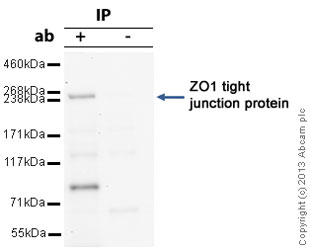
ZO1 tight junction protein was immunoprecipitated using 0.5mg Hek293 whole cell extract, 5µg of Mouse monoclonal to and 50µl of protein G magnetic beads (+). No antibody was added to the control (-).The antibody was incubated under agitation with Protein G beads for 10min, Hek293 whole cell extract lysate diluted in RIPA buffer was added to each sample and incubated for a further 10min under agitation.Proteins were eluted by addition of 40µl SDS loading buffer and incubated for 10min at 70°C; 10µl of each sample was separated on a SDS PAGE gel, transferred to a nitrocellulose membrane, blocked with 5% BSA and probed with ab61357.Secondary: Goat polyclonal to mouse IgG light chain specific (HRP) at 1/20,000 dilution.Band: 240kDa, non specific band - 90kDa: We are unsure as to the identity of this extra band; ZO1 tight junction protein
![All lanes : Anti-ZO1 tight junction protein antibody [mAbcam 61357] (ab61357) at 5 µg/mlLane 1 : HepG2 (Human hepatocellular liver carcinoma cell line) Whole Cell LysateLane 2 : HEK293 (Human embryonic kidney cell line) Whole Cell Lysate Lane 3 : A431 (Human epithelial carcinoma cell line) Whole Cell LysateLane 4 : Caco 2 (Human colonic carcinoma cell line) Whole Cell LysateLysates/proteins at 20 µg per lane.SecondaryGoat polyclonal to Mouse IgG - H&L - Pre-Adsorbed (HRP) at 1/3000 dilutiondeveloped using the ECL techniquePerformed under reducing conditions.](http://www.bioprodhub.com/system/product_images/ab_products/2/sub_5/25015_ZO1-tight-junction-protein-Primary-antibodies-ab61357-1.jpg)
All lanes : Anti-ZO1 tight junction protein antibody [mAbcam 61357] (ab61357) at 5 µg/mlLane 1 : HepG2 (Human hepatocellular liver carcinoma cell line) Whole Cell LysateLane 2 : HEK293 (Human embryonic kidney cell line) Whole Cell Lysate Lane 3 : A431 (Human epithelial carcinoma cell line) Whole Cell LysateLane 4 : Caco 2 (Human colonic carcinoma cell line) Whole Cell LysateLysates/proteins at 20 µg per lane.SecondaryGoat polyclonal to Mouse IgG - H&L - Pre-Adsorbed (HRP) at 1/3000 dilutiondeveloped using the ECL techniquePerformed under reducing conditions.
![Overlay histogram showing MCF-7 cells stained with ab61357 (red line). The cells were fixed with 80% methanol (5 min) and then permeabilized with 0.1% PBS-Tween for 20 min. The cells were then incubated in 1x PBS / 10% normal goat serum / 0.3M glycine to block non-specific protein-protein interactions followed by the antibody (ab61357, 1µg/1x106 cells) for 30 min at 22ºC. The secondary antibody used was DyLight® 488 goat anti-mouse IgG (H+L) (ab96879) at 1/500 dilution for 30 min at 22ºC. Isotype control antibody (black line) was mouse IgG1 [ICIGG1] (ab91353, 2µg/1x106 cells) used under the same conditions. Acquisition of >5,000 events was performed.](http://www.bioprodhub.com/system/product_images/ab_products/2/sub_5/25016_ZO1-tight-junction-protein-Primary-antibodies-ab61357-3.jpg)
Overlay histogram showing MCF-7 cells stained with ab61357 (red line). The cells were fixed with 80% methanol (5 min) and then permeabilized with 0.1% PBS-Tween for 20 min. The cells were then incubated in 1x PBS / 10% normal goat serum / 0.3M glycine to block non-specific protein-protein interactions followed by the antibody (ab61357, 1µg/1x106 cells) for 30 min at 22ºC. The secondary antibody used was DyLight® 488 goat anti-mouse IgG (H+L) (ab96879) at 1/500 dilution for 30 min at 22ºC. Isotype control antibody (black line) was mouse IgG1 [ICIGG1] (ab91353, 2µg/1x106 cells) used under the same conditions. Acquisition of >5,000 events was performed.

![All lanes : Anti-ZO1 tight junction protein antibody [mAbcam 61357] (ab61357) at 5 µg/mlLane 1 : HepG2 (Human hepatocellular liver carcinoma cell line) Whole Cell LysateLane 2 : HEK293 (Human embryonic kidney cell line) Whole Cell Lysate Lane 3 : A431 (Human epithelial carcinoma cell line) Whole Cell LysateLane 4 : Caco 2 (Human colonic carcinoma cell line) Whole Cell LysateLysates/proteins at 20 µg per lane.SecondaryGoat polyclonal to Mouse IgG - H&L - Pre-Adsorbed (HRP) at 1/3000 dilutiondeveloped using the ECL techniquePerformed under reducing conditions.](http://www.bioprodhub.com/system/product_images/ab_products/2/sub_5/25015_ZO1-tight-junction-protein-Primary-antibodies-ab61357-1.jpg)
![Overlay histogram showing MCF-7 cells stained with ab61357 (red line). The cells were fixed with 80% methanol (5 min) and then permeabilized with 0.1% PBS-Tween for 20 min. The cells were then incubated in 1x PBS / 10% normal goat serum / 0.3M glycine to block non-specific protein-protein interactions followed by the antibody (ab61357, 1µg/1x106 cells) for 30 min at 22ºC. The secondary antibody used was DyLight® 488 goat anti-mouse IgG (H+L) (ab96879) at 1/500 dilution for 30 min at 22ºC. Isotype control antibody (black line) was mouse IgG1 [ICIGG1] (ab91353, 2µg/1x106 cells) used under the same conditions. Acquisition of >5,000 events was performed.](http://www.bioprodhub.com/system/product_images/ab_products/2/sub_5/25016_ZO1-tight-junction-protein-Primary-antibodies-ab61357-3.jpg)